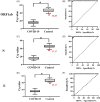Development of a multi-recombinase polymerase amplification assay for rapid identification of COVID-19, influenza A and B
- PMID: 36089764
- PMCID: PMC9538624
- DOI: 10.1002/jmv.28139
Development of a multi-recombinase polymerase amplification assay for rapid identification of COVID-19, influenza A and B
Abstract
The coronavirus disease 2019 (COVID-19) pandemic caused extensive loss of life worldwide. Further, the COVID-19 and influenza mix-infection had caused great distress to the diagnosis of the disease. To control illness progression and limit viral spread within the population, a real-time reverse-transcription PCR (RT-PCR) assay for early diagnosis of COVID-19 was developed, but detection was time-consuming (4-6 h). To improve the diagnosis of COVID-19 and influenza, we herein developed a recombinase polymerase amplification (RPA) method for simple and rapid amplification of Severe Acute Respiratory Syndrome Coronavirus 2 (SARS-CoV-2), the causative agent of COVID-19 and Influenza A (H1N1, H3N2) and B (influenza B). Genes encoding the matrix protein (M) for H1N1, and the hemagglutinin (HA) for H3N2, and the polymerase A (PA) for Influenza B, and the nucleocapsid protein (N), the RNA-dependent-RNA polymerase (RdRP) in the open reading frame 1ab (ORF1ab) region, and the envelope protein (E) for SARS-CoV-2 were selected, and specific primers were designed. We validated our method using SARS-CoV-2, H1N1, H3N2 and influenza B plasmid standards and RNA samples extracted from COVID-19 and Influenza A/B (RT-PCR-verified) positive patients. The method could detect SARS-CoV-2 plasmid standard DNA quantitatively between 102 and 105 copies/ml with a log linearity of 0.99 in 22 min. And this method also be very effective in simultaneous detection of H1N1, H3N2 and influenza B. Clinical validation of 100 cases revealed a sensitivity of 100% for differentiating COVID-19 patients from healthy controls when the specificity was set at 90%. These results demonstrate that this nucleic acid testing method is advantageous compared with traditional PCR and other isothermal nucleic acid amplification methods in terms of time and portability. This method could potentially be used for detection of SARS-CoV-2, H1N1, H3N2 and influenza B, and adapted for point-of-care (POC) detection of a broad range of infectious pathogens in resource-limited settings.
Keywords: COVID-19; RPA; SARS-CoV-2; influenza; laboratory diagnosis.
© 2022 The Authors. Journal of Medical Virology published by Wiley Periodicals LLC.
Conflict of interest statement
The authors declare no conflicts of interest.
Figures





Similar articles
-
Multiplex real-time reverse transcription recombinase-aided amplification assay for the detection of SARS-CoV-2, influenza A virus, and respiratory syncytial virus.Microbiol Spectr. 2025 Jun 3;13(6):e0275924. doi: 10.1128/spectrum.02759-24. Epub 2025 May 5. Microbiol Spectr. 2025. PMID: 40323293 Free PMC article.
-
Isothermal recombinase polymerase amplification-lateral flow detection of SARS-CoV-2, the etiological agent of COVID-19.J Virol Methods. 2021 Oct;296:114227. doi: 10.1016/j.jviromet.2021.114227. Epub 2021 Jul 2. J Virol Methods. 2021. PMID: 34224752 Free PMC article.
-
Developing a Loop-Mediated Isothermal Amplification Assay for the Rapid Detection of Seven Respiratory Viruses including SARS-CoV-2.Medicina (Kaunas). 2022 Sep 5;58(9):1224. doi: 10.3390/medicina58091224. Medicina (Kaunas). 2022. PMID: 36143901 Free PMC article.
-
Nucleic Acid Testing of SARS-CoV-2.Int J Mol Sci. 2021 Jun 7;22(11):6150. doi: 10.3390/ijms22116150. Int J Mol Sci. 2021. PMID: 34200331 Free PMC article. Review.
-
Recent developments in isothermal amplification technology for rapid detection of SARS-CoV-2.Anal Methods. 2025 Jan 23;17(4):652-664. doi: 10.1039/d4ay01106f. Anal Methods. 2025. PMID: 39679561 Review.
Cited by
-
Portable lab-on-a-chip platform enabling multiplex recombinant enzyme polymerase amplification detection of H5/H7/H10 avian influenza virus subtypes.Poult Sci. 2025 Jun 19;104(9):105463. doi: 10.1016/j.psj.2025.105463. Online ahead of print. Poult Sci. 2025. PMID: 40592291 Free PMC article.
-
Asymmetric parameter enhancement in the split-ring cavity array for virus-like particle sensing.Biomed Opt Express. 2023 Feb 22;14(3):1216-1227. doi: 10.1364/BOE.483831. eCollection 2023 Mar 1. Biomed Opt Express. 2023. PMID: 36950230 Free PMC article.
-
Advances in Diagnostic Techniques for Influenza Virus Infection: A Comprehensive Review.Trop Med Infect Dis. 2025 May 28;10(6):152. doi: 10.3390/tropicalmed10060152. Trop Med Infect Dis. 2025. PMID: 40559719 Free PMC article. Review.
-
Rapid and sensitive detection of chikungunya virus using one-tube, reverse transcription, semi-nested multi-enzyme isothermal rapid amplification, and lateral flow dipstick assays.J Clin Microbiol. 2024 Sep 11;62(9):e0038324. doi: 10.1128/jcm.00383-24. Epub 2024 Aug 14. J Clin Microbiol. 2024. PMID: 39140738 Free PMC article.
-
Advances in Simple, Rapid, and Contamination-Free Instantaneous Nucleic Acid Devices for Pathogen Detection.Biosensors (Basel). 2023 Jul 14;13(7):732. doi: 10.3390/bios13070732. Biosensors (Basel). 2023. PMID: 37504131 Free PMC article. Review.
References
Publication types
MeSH terms
Substances
LinkOut - more resources
Full Text Sources
Medical
Research Materials
Miscellaneous

